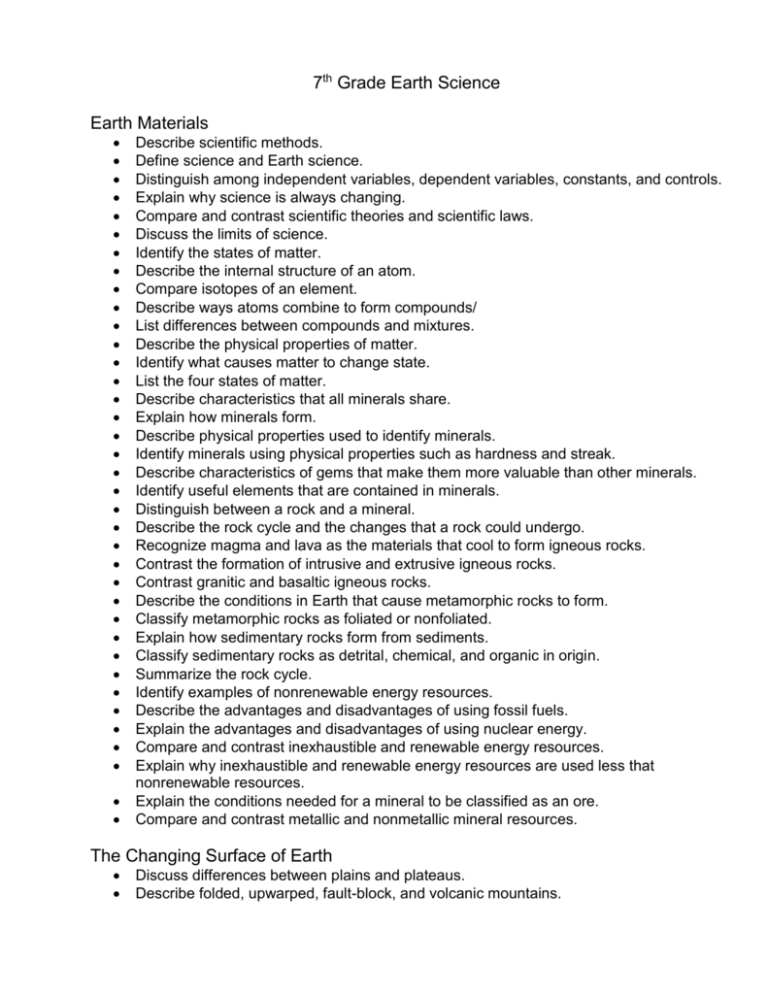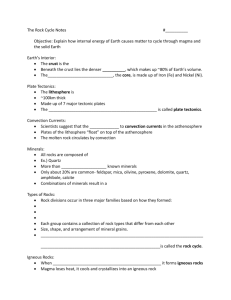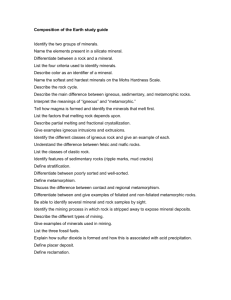File - Seoul Academy International School
advertisement

7th Grade Earth Science Earth Materials Describe scientific methods. Define science and Earth science. Distinguish among independent variables, dependent variables, constants, and controls. Explain why science is always changing. Compare and contrast scientific theories and scientific laws. Discuss the limits of science. Identify the states of matter. Describe the internal structure of an atom. Compare isotopes of an element. Describe ways atoms combine to form compounds/ List differences between compounds and mixtures. Describe the physical properties of matter. Identify what causes matter to change state. List the four states of matter. Describe characteristics that all minerals share. Explain how minerals form. Describe physical properties used to identify minerals. Identify minerals using physical properties such as hardness and streak. Describe characteristics of gems that make them more valuable than other minerals. Identify useful elements that are contained in minerals. Distinguish between a rock and a mineral. Describe the rock cycle and the changes that a rock could undergo. Recognize magma and lava as the materials that cool to form igneous rocks. Contrast the formation of intrusive and extrusive igneous rocks. Contrast granitic and basaltic igneous rocks. Describe the conditions in Earth that cause metamorphic rocks to form. Classify metamorphic rocks as foliated or nonfoliated. Explain how sedimentary rocks form from sediments. Classify sedimentary rocks as detrital, chemical, and organic in origin. Summarize the rock cycle. Identify examples of nonrenewable energy resources. Describe the advantages and disadvantages of using fossil fuels. Explain the advantages and disadvantages of using nuclear energy. Compare and contrast inexhaustible and renewable energy resources. Explain why inexhaustible and renewable energy resources are used less that nonrenewable resources. Explain the conditions needed for a mineral to be classified as an ore. Compare and contrast metallic and nonmetallic mineral resources. The Changing Surface of Earth Discuss differences between plains and plateaus. Describe folded, upwarped, fault-block, and volcanic mountains. Define latitude and longitude. Explain how latitude and longitude are used to identify locations on Earth. Determine the time and date in different time zones. Compare map projections and their uses. Analyze information from topographic, geologic, and satellite maps. Explain how mechanical and chemical weathering differs. Describe how weathering affects Earth’s surface. Explain how climate affects weathering. Explain how soil forms. Describe soil characteristics. Describe factors that affect the development of soil. Explain why soil is important. Evaluate ways that human activities have affected Earth’s soil. Describe ways to reduce soil erosion. Explain the differences between erosion and deposition. Compare and contrast slump, creep, rock falls, rock slides, and mudflows. Explain why building on steep slopes might not be wise. Explain how glaciers move. Describe evidence of glacial erosion and deposition. Compare and contrast till and outwash. Explain how wind causes deflation and abrasion. Recognize how loess and dunes form. Identify the causes of runoff. Compare rill, gully, sheet, and stream erosion. Identify three stages of stream development. Explain how deltas and alluvial fans form. Recognize the importance of ground water. Describe the effect that soil and rock permeability have on groundwater movement. Explain how groundwater dissolves and deposits minerals. Identify the causes of shoreline erosion. Compare and contrast different types of shoreline. Describe some origins of sand. Earth’s Internal Processes Describe the hypothesis of continental drift. Identify evidence supporting continental drift. Explain seafloor spreading. Recognize how age and magnetic clues support seafloor spreading. Compare and contrast different types of plate boundaries. Explain how heat inside Earth can cause plate tectonics. Recognize features caused by plate tectonics. Explain how earthquakes result from the buildup of energy in rocks. Explain how tension, compression, and shear forces make rocks move along faults. Distinguish among normal, reverse, and strike-slip faults. Explain how earthquake energy travels in seismic waves. Distinguish among primary, secondary, and surface waves. Describe the structure of Earth’s interior. Explain where most earthquakes in the world occur. Describe how scientists measure earthquakes. List ways to make your classroom and home earthquake-safe. Describe how volcanoes can affect people. List conditions that cause volcanoes to form. Identify the relationship between volcanoes and Earth’s moving plates. Explain how the explosiveness of a volcanic eruption is related to the silica and water vapor content of its magma. List three forms of volcanoes. Describe intrusive igneous rock features and how they form. Explain how a volcanic neck and a caldera form. Change and Earth’s History List the conditions necessary for fossils to form. Describe several processes of fossil formation. Explain how fossil correlation is used to determine the age of rocks. Determine how fossils can be used to explain changes in Earth’s surface, life forms, and environments. Describe methods used to assign relative ages to rock layers. Interpret gaps in the rock record. Give an example of how a rock layer can be correlated with other rock layers. Identify how absolute rock age differs from relative age. Describe how the half-life of an isotope can be used to determine the age of a rock. Explain how geologic time can be divided into units. Relate changes of Earth’s organisms to divisions on the geologic time scale. Describe how plate tectonics affects species. Identify Precambrian and Paleozoic life forms. Draw conclusions about how species adapted to changing environments in Precambrian time and the Paleozoic Era. Describe changes in Earth’s life forms at the end of the Paleozoic Era. Compare and contrast characteristic life forms in the Mesozoic and Cenozoic Era. Explain how changes caused by plate tectonics affected organisms during the Mesozoic Era. Identify when humans first appeared on Earth. Earth’s Air and Water Identify the gases in Earth’s atmosphere. Describe the structure of Earth’s atmosphere. Explain what causes air pressure. Describe what happens to the energy Earth receives from the Sun. Compare and contrast radiation, conduction, and convection. Explain the water cycle and its effect on weather patterns and climate. Explain why different latitudes on Earth receive different amounts of solar energy. Describe the Coriolis effect. Explain how the land and water surfaces affect the overlying air. Explain how solar heating and water vapor in the atmosphere affect weather. Discuss how clouds form and how they are classified. Explain how rain, snow, sleet, and hail develop. Describe how weather is associated with fronts and high and low pressure areas. Explain how tornadoes develop from thunderstorms. Describe the changes of severe weather. Explain how weather data are collected for weather maps and forecasts. Identify the symbols used in a weather station model. Describe what determines climate. Explain how latitude, ocean, and other factors affect the climate of a region. Describe a climate classification system. Explain how organisms adapt to particular climates. Explain what causes seasons. Describe how El Niño affects climate. Explain possible causes of climatic change. Identify the origin of the water on Earth’s oceans. Explain how dissolved salts and other substances get into seawater. Describe the composition of seawater. Explain how winds and the Coriolis effect influence surface currents. Discuss the temperatures of coastal waters. Describe density currents. Describe wave formation. Distinguish between the movement of the particles in a wave and the movement of the wave. Explain how ocean tides form. Differentiate between a continental shelf and a continental slope. Describe a mid-ocean ridge, an abyssal plain, and an ocean trench. Identify the different minerals found in the continental shelf and on the deep ocean. Describe photosynthesis and chemosynthesis in the oceans. List the key characteristics of plankton, nekton, and benthos. Compare and contrast ocean margin habitats. List five types of ocean pollution. Explain how ocean pollution affects the entire world. Explain how ocean pollution can be controlled. You and the Environment Describe how fast the human population is increasing. Identify reasons for Earth’s rapid increase in human population. List several ways each person can affect the environment. Identify ways that land is used. Explain how land use can cause environmental problems. Identify things you can do to help protect the environment. Identify three ways to conserve resources. Explain the advantages of recycling. Identify types of water pollution and their effects. Discuss ways to reduce water pollution. List ways that you can help reduce water pollution. List the different sources of air pollutants. Describe how air pollution affects people and the environment. Discuss how air pollution can be reduced. Astronomy Explain the electromagnetic spectrum. Identify the differences between refracting and reflecting telescopes. Recognize the differences between optical and radio telescopes. Compare and contrast natural and artificial satellites. Identify the differences between artificial satellites and space probes. Explain the history of the race to the moon. Explain the benefits of the space shuttle. Identify the usefulness of orbiting space stations. Explain future space missions. Identify the applications of space technology in everyday life. Examine Earth’s physical characteristics. Differentiate between rotation and revolution. Discuss what causes seasons to change. Identify phases of the Moon and their cause. Explain why solar and lunar eclipses occur. Infer what the Moon’s surface features may reveal about its history. Describe recent discoveries about the Moon. Examine facts about the Moon that may influence future space travel. Compare models of the solar system. Explain that gravity holds planets in orbit around the Sun. List the inner planets in order from the Sun. Describe each inner planet. Compare and contrast Venus and Earth. Describe the characteristics of the outer planets. Describe how comets change when they approach the Sun. Distinguish between comets, meteoroids, and asteroids. Explain that objects from space sometimes impact Earth. Explain why some constellations are visible only during certain seasons. Distinguish between absolute magnitude and apparent magnitude. Explain that the Sun is the closest star to Earth. Describe the structure of the Sun. Describe sunspots, prominences, and solar flares. Describe how stars are classified. Compare the Sun to other stars in the H-R diagram. Describe how stars evolve. Describe the Sun’s position in the Milky Way Galaxy. Explain that the same natural laws that apply to our solar system also apply to other galaxies.






